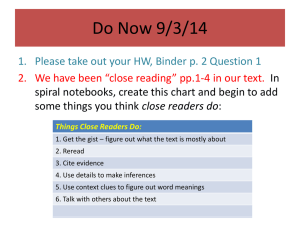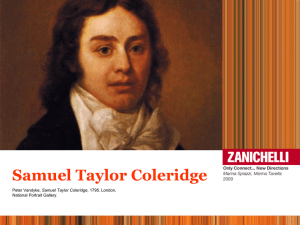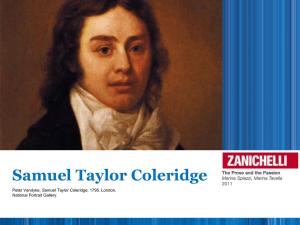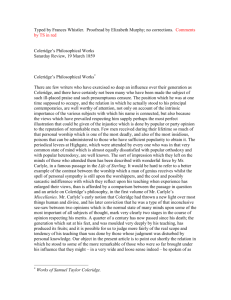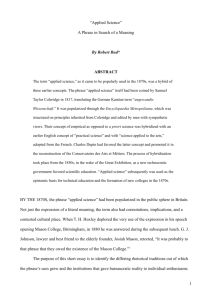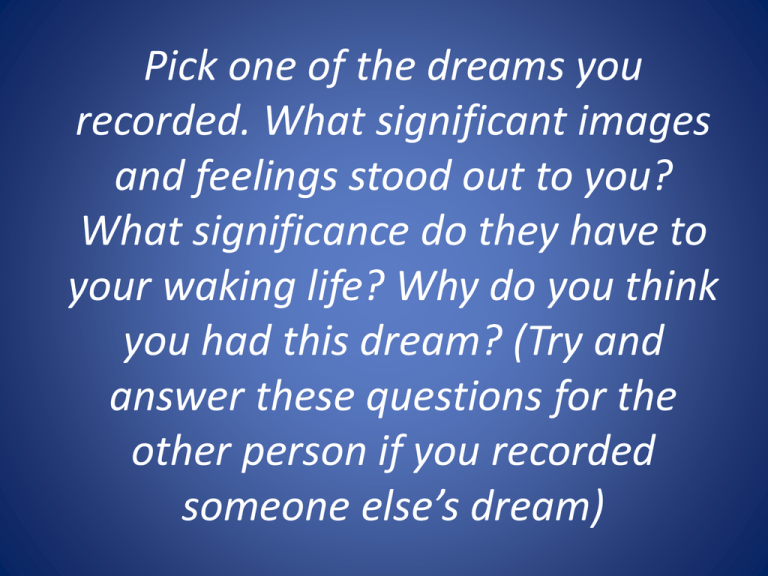
Pick one of the dreams you
recorded. What significant images
and feelings stood out to you?
What significance do they have to
your waking life? Why do you think
you had this dream? (Try and
answer these questions for the
other person if you recorded
someone else’s dream)
Carl Jung (1875-1961) Sigmund Freud (1856-1939)
1. Expression of current conditions
in outside world
2. Distinctive language of symbols,
images, metaphors
3. Compensation for imbalances in
the psyche
4. Archetypes (universally
understood symbol or pattern of
behavior, a prototype upon which
others are copied, patterned, or
emulated). In psychology an
archetype is a model of a person,
personality, or behavior.
Examples: The hero, the trickster,
the child.
1. Believes sex is a root cause of
almost everything in dreams
2. The unconscious can be
disturbing so it filters through
symbolic language
3. “Free Association” your
association with certain images
and things
Example: Car freedom, journey,
control
Similarities in Dream Theory
1. Dreams have importance
2. Dreams speak with symbols
3. Dreams deal with the unconscious mind
{Dreams and Writing}
• How is interpreting someone else’s dream and
interpreting someone else’s writing similar?
Cornell Notes…
1. In the left column write questions that you
have about Coleridge
2. In the right column write answers as we go
over them in the power point.
Samuel Taylor Coleridge
and
“Kubla Khan”
The Life and Times of Coleridge
• Coleridge was born in 1772 in Devonshire,
England.
• Like Wordsworth, Coleridge lost his father at a
young age (9 years old to be exact)
• He became introverted and the result of this
was a lonely and friendless youth.
Imagination and the Outdoors
• Deciding to spend a lot of time alone,
Coleridge turned inward with his imagination
and outward to nature as an escape.
• He loved imaginative, adventurous and exotic
stories such as Arabian Nights.
• He loved the outdoors so much that he nearly
lost his life on one occasion in which he spent
the night outdoors and came close to freezing
to death.
Near Death Experience
• The event of almost freezing to death left him
with a severe case of rheumatism (a kind of
arthritis) that plagued him for the rest of his
life.
• At the time, opium was a common treatment
for such ailments. Coleridge became addicted
to the drug, but felt very remorseful about it.
• Quote: “I may say that I was seduced into the
accursed Habit ignorantly.”
Education
• Like Wordsworth, Coleridge was educated at
Cambridge.
• Again, like Wordsworth he was inspired by the
ideals of the French Revolution.
• Coleridge had heard of and started reading
Wordsworth’s work and was greatly moved by
what he read.
Forces Unite!
• When Coleridge was 25 years old, he met
Wordsworth and the two had instant poetic
chemistry.
• Ironically, at this time, it was Wordsworth who
was in a “creative funk” that Coleridge helped
to break.
• They became good friends and roommates
along with Wordsworth’s sister and best
friend, Dorothy.
The Beginning of a New Era
• As we now know, the Romantic Age is usually
considered “born” through the publication of
Lyrical Ballads, a collaborative collection of
poetry by Wordsworth and Coleridge.
• Coleridge’s “Kubla Khan” is featured in the
collection.
“Kubla Khan”: Paradise, Interrupted
"In Xanadu did Kubla Khan / A stately pleasure-dome decree..."
The Backstory…
• One night Coleridge wasn't feeling well. To dull
the pain, he took a dose of opium (used as a
medicine in the 19th century). He fell asleep and
had a strange dream about a Mongol emperor
named Kubla Khan.
• Coleridge dreamed that he was actually writing a
poem in his sleep, and when he woke up after a
few hours, he sat down to record the dream
poem. He meant to write several hundred lines,
but he was interrupted by someone from Porlock
who had come to see him on business.
• When he came back to the poem, he had
forgotten the rest. The last stanza was written
after his visitor left.
“Kubla Khan” is a BALLAD -- Hence,
Lyrical Ballads
• Traditionally, most ballads are narrative in nature, with
a self contained story
• They are often concise and relying on imagery, rather
than description
• Most often, literary ballads use a regular stanza form of
4-line, 6-line, or 8-line stanzas
• Generally you will find a regular rhyme scheme and
rhythm, but this may vary from stanza to stanza (for a
reason)
• Pay close attention to how the poem sounds - many
poets chose the form to achieve an effective sound
(humorous, sad, lonely, eerie) as well as for story and
meaning
On to the Poem!
• Close your eyes and listen as I read
• When you open your eyes, sketch the first
image you remember from the poem
{Questions for Thought…}
• What is the story or narrative of this poem?
• How is the stanza written after the interruption
different in mood from the others?
• How do dreams and Romanticism relate to one
another? Do they share similarities?
• In many ways, “Kubla Khan” is a poem whose
interpretation depends on a knowledge of events that
occurred outside of the poem itself. How does the
story of the person from Porlock affect the ways in
which the poem can be understood? Is it possible to
find any significance in “Kubla Khan” without
knowledge of Coleridge’s opium dream?
{Questions Continued}
• Which characteristics of Romanticism are
evident in the poem?
• How does the structure of his ballad
create/add meaning to the poem?
• How/why did Coleridge use his dreams to
influence his poetry?
{Homework Response}
• Does an experience need to be REAL for it to
have an impact? Are imagined emotions in
dreams just as valid and significant as those in
our waking life? Refer to “Kubla Khan” in your
answer.

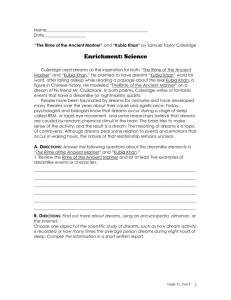
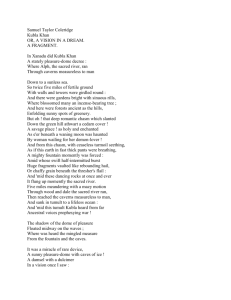
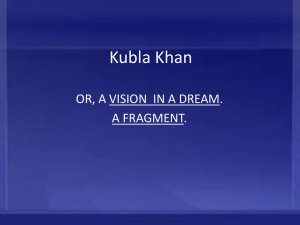
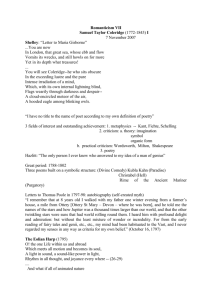
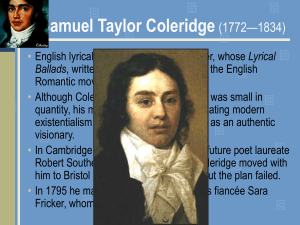
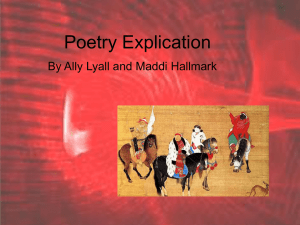
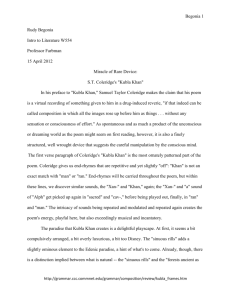
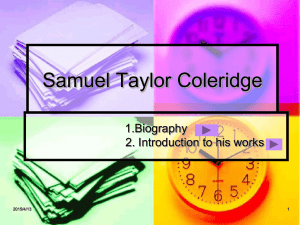
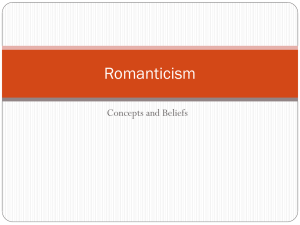
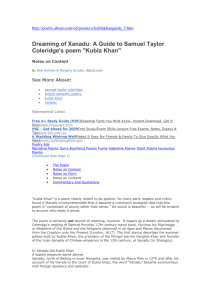
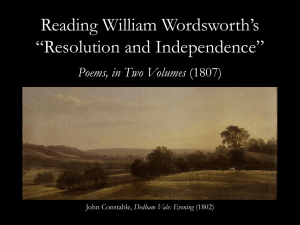
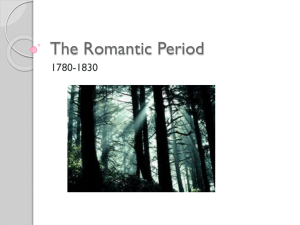

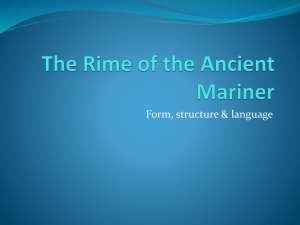
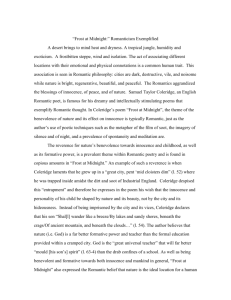
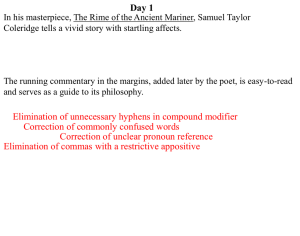
![Special Author: Coleridge [DOCX 17.00KB]](http://s3.studylib.net/store/data/006968656_1-dea8d59f2ad6dce7da91a635543a7277-300x300.png)
